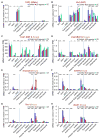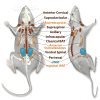An Adipose Tissue Atlas: An Image-Guided Identification of Human-like BAT and Beige Depots in Rodents
- PMID: 29320705
- PMCID: PMC5764189
- DOI: 10.1016/j.cmet.2017.12.004
An Adipose Tissue Atlas: An Image-Guided Identification of Human-like BAT and Beige Depots in Rodents
Abstract
[18F]Fluorodeoxyglucose-PET/CT (18F-FDG-PET/CT) imaging has been invaluable for visualizing metabolically active adipose tissues in humans with potential anti-diabetic and anti-obesity effects. To explore whether mice display human-like fat depots in anatomically comparable regions, we mapped fat depots using glucose or fatty acid imaging tracers, such as 18F-FDG through PET/CT or [123/125I]-β-methyl-p-iodophenyl-pentadecanoic acid with SPECT/CT imaging, to analogous depots in mice. Using this type of image analysis with both probes, we define a large number of additional areas of high metabolic activity corresponding to novel fat pads. Histological and gene expression analyses validate these regions as bona fide fat pads. Our findings indicate that fat depots of rodents show a high degree of topological similarity to those of humans. Studies involving both glucose and lipid tracers indicate differential preferences for these substrates in different depots and also suggest that fatty acid-based visualized approaches may reveal additional brown adipose tissue and beige depots in humans.
Keywords: BAT; PET/CT; SPECT/CT; beige; bona fide thermogenic fat tissues; glucose or fatty acid imaging tracers; human-like; imaging; marker genes; morphology.
Copyright © 2018 Elsevier Inc. All rights reserved.
Conflict of interest statement
Figures







References
-
- Admiraal WM, Holleman F, Bahler L, Soeters MR, Hoekstra JB, Verberne HJ. Combining 123I-metaiodobenzylguanidine SPECT/CT and 18F-FDG PET/CT for the assessment of brown adipose tissue activity in humans during cold exposure. J Nucl Med. 2013;54:208–212. - PubMed
-
- Betz MJ, Enerback S. Human Brown Adipose Tissue: What We Have Learned So Far. Diabetes. 2015;64:2352–2360. - PubMed
-
- Cannon B, Nedergaard J. Brown adipose tissue: function and physiological significance. Physiol Rev. 2004;84:277–359. - PubMed
-
- Ci X, Frisch F, Lavoie F, Germain P, Lecomte R, van Lier JE, Benard F, Carpentier AC. The effect of insulin on the intracellular distribution of 14(R,S)-[18F]Fluoro-6-thia-heptadecanoic acid in rats. Mol Imaging Biol. 2006;8:237–244. - PubMed
-
- Cinti S. Transdifferentiation properties of adipocytes in the adipose organ. Am J Physiol Endocrinol Metab. 2009;297:E977–986. - PubMed
Publication types
MeSH terms
Substances
Grants and funding
LinkOut - more resources
Full Text Sources
Other Literature Sources
Molecular Biology Databases

